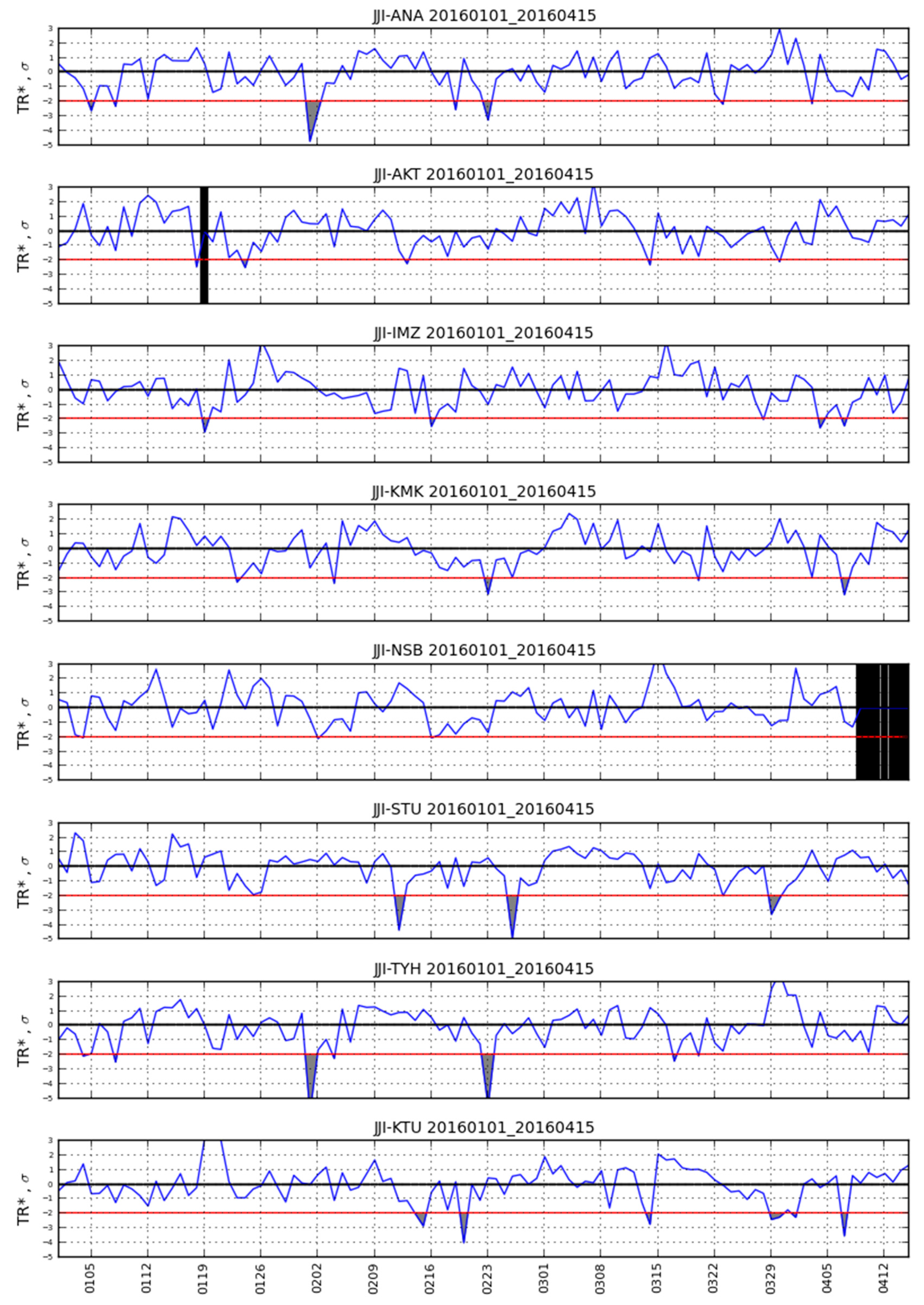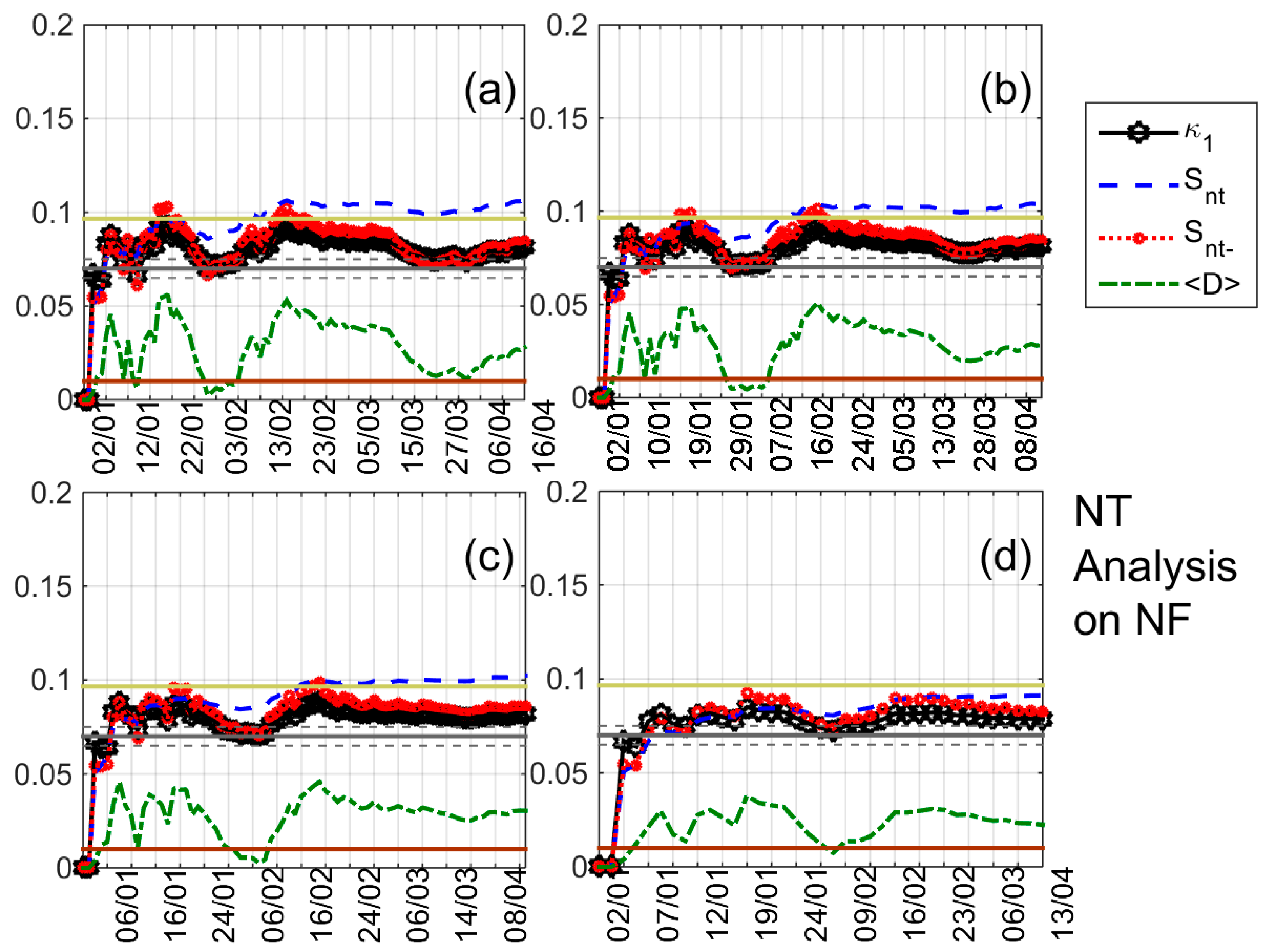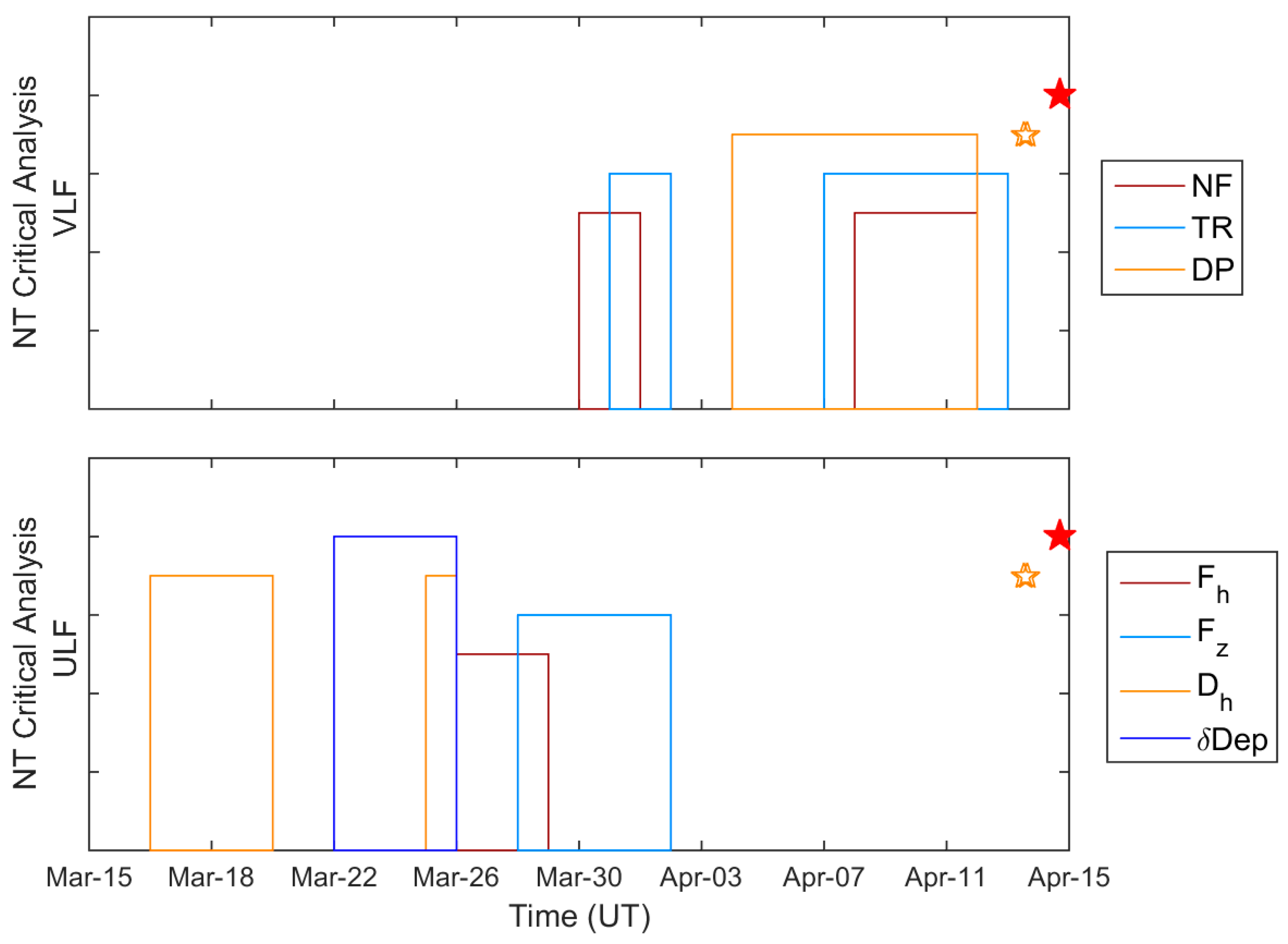Criticality Analysis of the Lower Ionosphere Perturbations Prior to the 2016 Kumamoto (Japan) Earthquakes as Based on VLF Electromagnetic Wave Propagation Data Observed at Multiple Stations
Abstract
:1. Introduction
2. EQs Information, VLF/LF Stations Network, Subionospheric Propagation Data
3. Natural Time Analysis Method
4. Analysis of Lower Ionosphere Nighttime Fluctuations Prior to the 2016 Kumamoto EQs
- (1)
- Criticality has been revealed for all eight stations, but for different propagation characteristics (, , and ) we have criticality for different combinations of stations and dates.
- (2)
- It is especially worth noting that the receiving stations KMK, TYH, ANA and KTU, which are all situated on the east (Pacific) coast of Japan showed either marginal or clear indications of criticality from 28 March 2016 up to 1–2 April 2016. However, it may be possible that this behavior is related to the M5.9 EQ which happened in the Pacific Ocean coast of Japan on 1 April 2016, 02:39:08.06 UT (33.3835° N, 136.3857° E), depth = 14 km (please also see Figure 1), and not to the 2016 Kumamoto EQs.
- (3)
- After those dates, clear criticality indications are progressively appearing from 5 April 2016 (i.e., 9–10 days before the 2016 Kumamoto EQs) up to 13 April 2016 (i.e., 1–2 days before the 2016 Kumamoto EQs), while marginal indications of criticality are observed even on 15 April 2016 but only at KMK station.
- (4)
- The timeline of clear criticality indications develops as follows: (a) first criticality is found in of the JJI-KTU path (5–7 April 2016); (b) then, criticality appears in the JJI-STU path (starting from 8 April 2016 in , and ); (c) between 9 April 2016 and 12–13 April 2016, clear criticality evidence appear in five propagation paths of JJI-STU, JJI-KTU, JJI-IMZ, JJI-KMK, JJI-AKT, some of them presenting critical characteristics in more than one of the analyzed quantities (, , and ).
5. Discussion
6. Conclusions
Acknowledgments
Author Contributions
Conflicts of Interest
References
- Hayakawa, M.; Molchanov, O.A. (Eds.) Seismo Electromagnetics: Lithosphere-Atmosphere-Ionosphere Coupling; TERRAPUB: Tokyo, Japan, 2002; ISBN 4-88704-130-6. [Google Scholar]
- Pulinets, S.; Boyarchuk, K. Ionospheric Precursors of Earthquakes; Springer: Berlin, Germany, 2004; ISBN 978-3-540-26468-2. [Google Scholar]
- Varotsos, P.A. The Physics of Seismic Electric Signals; TERRAPUB: Tokyo, Japan, 2005; ISBN 4-88704-136-5. [Google Scholar]
- Molchanov, O.A.; Hayakawa, M. Seismo Electromagnetics and Related Phenomena: History and Latest Results; TERRAPUB: Tokyo, Japan, 2008; ISBN 978-4-88704-143-1. [Google Scholar]
- Hattori, K. ULF geomagnetic changes associated with major earthquakes. In Earthquake Prediction Studies: Seismo Elecromagnetics; Hayakawa, M., Ed.; TERRAPUB: Tokyo, Japan, 2013; pp. 129–152. ISBN 978-4-88704-163-9. [Google Scholar]
- Eftaxias, K.; Potirakis, S.M. Current challenges for pre-earthquake electromagnetic emissions: Shedding light from micro-scale plastic flow, granular packings, phase transitions and self-affinity notion of fracture process. Nonlinear Process. Geophys. 2013, 20, 771–792. [Google Scholar] [CrossRef]
- Hayakawa, M. Earthquake Prediction with Radio Techniques; John Willey and Sons: Singapore, 2015; ISBN 978-1-118-77016-0. [Google Scholar]
- Potirakis, S.M.; Contoyiannis, Y.; Melis, N.S.; Kopanas, J.; Antonopoulos, G.; Balasis, G.; Kontoes, C.; Nomicos, C.; Eftaxias, K. Recent seismic activity at Cephalonia (Greece): A study through candidate electromagnetic precursors in terms of non-linear dynamics. Nonlinear Process. Geophys. 2016, 23, 223–240. [Google Scholar] [CrossRef]
- Liu, J.Y. Earthquake precursors observed in the ionospheric F-region. In Electromagnetic Phenomena Associated with Earthquakes; Hayakawa, M., Ed.; Transworld Research Network: Trivandrum, India, 2009; pp. 187–204. ISBN 978-81-7895-297-0. [Google Scholar]
- Hayakawa, M.; Kasahara, Y.; Nakamura, T.; Muto, F.; Horie, T.; Maekawa, S.; Hobara, Y.; Rozhnoi, A.; Solovieva, M.; Molchanov, O.A. A statistical study on the correlation between lower ionospheric perturbations as seen by subionospheric VLF/LF propagation and earthquakes. J. Geophys. Res. Space Phys. 2010, 115. [Google Scholar] [CrossRef]
- Kon, S.; Nishihashi, M.; Hattori, K. Ionospheric anomalies possibly associated with M ≥ 6.0 earthquakes in the Japan area during 1998–2010: Case studies and statistical study. J. Asian Earth Sci. 2011, 41, 410–420. [Google Scholar] [CrossRef]
- Hayakawa, M. Probing the lower ionospheric perturbations associated with earthquakes by means of subionospheric VLF/LF propagation. Earthq. Sci. 2011, 24, 609–637. [Google Scholar] [CrossRef]
- Chmyrev, V.M.; Isaev, N.V.; Bilichenko, S.V.; Stanev, G.A. Observation by space-borne detectors of electric fields and hydromagnetic waves in the ionosphere over on earthquake center. Phys. Earth Planet. Int. 1989, 57, 110–114. [Google Scholar] [CrossRef]
- Fraser-Smith, A.C.; Bernardi, A.; McGill, P.R.; Ladd, M.E.; Helliwell, R.A.; Viilard, O.G. Low-frequency magnetic field measurements near the epicenter of the Ms 7.1 Loma Prieta Earthquake. Geophys. Rev. Lett. 1990, 17, 1465–1468. [Google Scholar] [CrossRef]
- Kopytenko, Y.A.; Matiashvili, T.G.; Voronov, P.M.; Kopytenko, E.A.; Molchanov, O.A. Detection of ultra-low frequency emissions connected with the Spitak earthquake and its aftershock activity, based on geomagnetic pulsations data at Dusheti and Vardzia observatories. Phys. Earth Planet. Int. 1993, 77, 85–95. [Google Scholar] [CrossRef]
- Aleksandrin, S.Y.; Galper, A.M.; Grishantzeva, L.A.; Koldashov, S.V.; Maslennikov, L.V.; Murashov, A.M.; Picozza, P.; Sgrigna, V.; Voronov, S.A. High-energy charged particle bursts in near-Earth space as earthquake precursors. Ann. Geophys. 2003, 21, 597–602. [Google Scholar] [CrossRef]
- Parrot, M. (Ed.) First results of the DEMETER micro-satellite. Planet. Space Sci. 2006, 54, 411–558. [Google Scholar]
- Liu, J.Y.; Chen, C.H.; Chen, Y.I.; Yang, W.H.; Oyama, K.I.; Kuo, K.W. A statistical study of ionospheric earthquake precursors monitored by using equatorial ionization anomaly of GPS TEC in Taiwan during 2001–2007. J. Asian Earth Sci. 2010, 39, 76–80. [Google Scholar] [CrossRef]
- Anagnostopoulos, G.C.; Vassiliadis, E.; Pulinets, S. Characteristics of flux-time profiles, temporal evolution, and spatial distribution of radiation-belt electron precipitation bursts in the upper ionosphere before great and giant earthquakes. Ann. Geophys. 2012, 55, 21–36. [Google Scholar] [CrossRef]
- Parrot, M. Satellite observations of ionospheric perturbations related to seismic activity. In Earthquake Prediction Studies: Seismo Electromagnetics; Hayakawa, M., Ed.; TERRAPUB: Tokyo, Japan, 2013; pp. 1–16. ISBN 978-4-88704-163-9. [Google Scholar]
- Sano, Y.; Takahata, N.; Kagoshima, T.; Shibata, T.; Onoue, T.; Zhao, D. Groundwater helium anomaly reflects strain change during the 2016 Kumamoto earthquake in Southwest Japan. Nat. Sci. Rep. 2016, 6, 37939. [Google Scholar] [CrossRef] [PubMed]
- Nagao, T.; Enomoto, Y.; Fujinawa, Y.; Hata, M.; Hayakawa, M.; Huang, Q.; Izutsu, J.; Kushida, Y.; Maeda, K.; Oike, K.; et al. Electromagnetic anomalies associated with 1995 Kobe earthquake. J. Geodyn. 2002, 33, 401–411. [Google Scholar] [CrossRef]
- Iwata, T.; Umeno, K. Preseismic ionospheric anomalies detected before the 2016 Kumamoto earthquake. J. Geophys. Res. 2017, 122, 3602–3616. [Google Scholar] [CrossRef]
- Kobari, T.; Han, P.; Hattori, K. b-value and GIM-TEC variations for Tokachi region and the 2016 Kumamoto earthquakes. In Proceedings of the International Workshop on Earthquake Preparation Process 2016—Observation, Validation, Modeling, Forecasting (IWEP2016), Chiba University, Chiba, Japan, 27–28 May 2016. [Google Scholar]
- Yagmur, M.; Hirooka, S.; Hattori, K. 3D Structure of ionospheric disturbances related to large earthquakes. In Proceedings of the International Workshop on Earthquake Preparation Process 2016—Observation, Validation, Modeling, Forecasting (IWEP2016), Chiba University, Chiba, Japan, 27–28 May 2016. [Google Scholar]
- Ouzounov, D.; Hattori, K.; Pulinets, S.; Petrov, L. Observation of transient signatures in atmosphere and ionosphere prior to the 2016 Kumamoto earthquake in Japan. Preliminary results. In Proceedings of the Japan Geoscience Union Meeting 2016, Chiba, Japan, 22–26 May 2016. [Google Scholar]
- Ouzounov, D.; Pulinets, S.; Hattori, K.; Liu, T.; Kafatos, M. An interdisciplinary approach of utilizing pre-earthquake signals for short-term prediction studies. In Proceedings of the 35th General Assembly of the European Seismological Commission, Trieste, Italy, 4–10 September 2016. ESC2016-401-1. [Google Scholar]
- Hayakawa, M.; Asano, T. Subionospheric VLF propagation anomaly prior to the Kumamoto earthquake in April, 2016. New Concepts Glob. Tecton. J. 2016, 4, 273–276. [Google Scholar]
- Asano, T.; Hayakawa, M. On the lower ionospheric perturbation for the 2016 Kumamoto earthquakes on the basis of VLF propagation data observed at multiple stations and wave-hop theoretical computations. In Proceedings of the International Workshop on Earthquake Preparation Process 2017—Observation, Validation, Modeling, Forecasting (IWEP2017), Chiba University, Chiba, Japan, 26–27 May 2017. [Google Scholar]
- Schekotov, A.; Izutsu, J.; Asamo, T.; Potirakis, S.M.; Hayakawa, M. Electromagnetic precursors to the 2016 Kumamoto earthquakes. Open J. Earthq. Res. 2017, 6, 168–179. [Google Scholar] [CrossRef]
- Potirakis, S.M.; Schekotov, A.; Asano, T.; Hayakawa, M. Natural time analysis on the ultra-low frequency magnetic field variations prior to the 2016 Kumamoto (Japan) earthquakes. J. Asian Earth Sci. 2018, 154, 419–427. [Google Scholar] [CrossRef]
- Potirakis, S.M.; Contoyiannis, Y.; Asano, T.; Hayakawa, M. Intermittency-induced criticality in the lower ionosphere prior to the 2016 Kumamoto earthquakes as embedded in the VLF propagation data observed at multiple stations. Tectonophysics 2018, 722, 422–431. [Google Scholar] [CrossRef]
- Varotsos, P.A.; Sarlis, N.V.; Skordas, E.S. Long-range correlations in the electric signals that precede rupture. Phys. Rev. E 2002, 66, 011902. [Google Scholar] [CrossRef] [PubMed]
- Varotsos, P.A.; Sarlis, N.V.; Tanaka, H.K.; Skordas, E.S. Similarity of fluctuations in correlated systems: The case of seismicity. Phys. Rev. E 2005, 72, 041103. [Google Scholar] [CrossRef] [PubMed]
- Varotsos, P.A.; Sarlis, N.V.; Skordas, E.S. Natural Time Analysis: The New View of Time; Springer: Berlin, Germany, 2011; ISBN 978-3-642-16449-1. [Google Scholar]
- Potirakis, S.M.; Karadimitrakis, A.; Eftaxias, K. Natural time analysis of critical phenomena: The case of pre-fracture electromagnetic emissions. Chaos Interdiscip. J. Nonlinear Sci. 2013, 23, 023117. [Google Scholar] [CrossRef] [PubMed]
- Potirakis, S.M.; Contoyiannis, Y.; Eftaxias, K.; Koulouras, G.; Nomicos, C. Recent field observations indicating an earth system in critical condition before the occurrence of a significant earthquake. IEEE Geosci. Remote Sens. Lett. 2015, 12, 631–635. [Google Scholar] [CrossRef]
- Hayakawa, M.; Schekotov, A.; Potirakis, S.M.; Eftaxias, K.; Li, Q.; Asano, T. An integrated study of ULF magnetic field variations in association with the 2008 Sichuan earthquake, on the basis of statistical and critical analyses. Open J. Earthq. Res. 2015, 4, 85–93. [Google Scholar] [CrossRef]
- Hayakawa, M.; Schekotov, A.; Potirakis, S.; Eftaxias, K. Criticality features in ULF magnetic fields prior to the 2011 Tohoku earthquake. Proc. Jpn. Acad. Ser. B 2015, 91, 25–30. [Google Scholar] [CrossRef] [PubMed]
- Potirakis, S.M.; Eftaxias, K.; Schekotov, A.; Yamaguchi, H.; Hayakawa, H. Criticality features in ultra-low frequency magnetic fields prior to the 2013 M6.3 Kobe earthquake. Ann. Geophys. 2016, 59, 0317. [Google Scholar] [CrossRef]
- Rozhnoi, A.; Solovieva, M.; Hayakawa, M. VLF/LF signals method for searching of electromagnetic earthquake precursors. In Earthquake Prediction Studies: Seismo Electromagnetics; Hayakawa, M., Ed.; TERRAPUB: Tokyo, Japan, 2013; pp. 31–48. ISBN 978-4-88704-163-9. [Google Scholar]
- Himematsu, Y.; Furuya, M. Fault source model for the 2016 Kumamoto earthquake sequence based on ALOS-2/PALSAR-2 pixel-offset data: Evidence for dynamic slip partitioning. Earth Planets Space 2016, 68, 169. [Google Scholar] [CrossRef]
- Varotsos, P.A.; Sarlis, N.V.; Skordas, E.S. Spatio-temporal complexity aspects on the interrelation between seismic electric signals and seismicity. Practica Athens Acad. 2001, 76, 294–321. [Google Scholar]
- Abe, S.; Sarlis, N.V.; Skordas, E.S.; Tanaka, H.K.; Varotsos, P.A. Origin of the usefulness of the natural-time representation of complex time series. Phys. Rev. Lett. 2005, 94, 170601. [Google Scholar] [CrossRef] [PubMed]
- Varotsos, P.A.; Sarlis, N.V.; Skordas, E.S.; Uyeda, S.; Kamogawa, M. Natural time analysis of critical phenomena. Proc. Natl. Acad. Sci. USA 2011, 108, 11361–11364. [Google Scholar] [CrossRef]
- Varotsos, P.A.; Sarlis, N.V.; Skordas, E.S.; Tanaka, H.K.; Lazaridou, M.S. Entropy of seismic electric signals: Analysis in the natural time under time reversal. Phys. Rev. E 2006, 73, 031114. [Google Scholar] [CrossRef] [PubMed]
- Sarlis, N.V.; Skordas, E.S.; Varotsos, P.A. Similarity of fluctuations in systems exhibiting self-organized criticality. Europhys. Lett. 2011, 96, 28006. [Google Scholar] [CrossRef]
- Sarlis, N.V.; Skordas, E.S.; Lazaridou, M.S.; Varotsos, P.A. Investigation of seismicity after the initiation of a Seismic Electric Signal activity until the main shock. Proc. Jpn. Acad. Ser. B 2008, 84, 331–343. [Google Scholar] [CrossRef]
- Rozhnoi, A.; Solovieva, M.; Levin, B.; Hayakawa, M.; Fedun, V. Meteorological effects in the lower ionosphere as based on VLF/LF signal observations. Nat. Hazards Earth Syst. Sci. 2014, 14, 2671–2679. [Google Scholar] [CrossRef]
- Hayakawa, M.; Asano, T.; Rozhnoi, A.; Solovieva, M. VLF/LF sounding of ionospheric perturbations and possible association with earthquakes. In Pre-Earthquake Processes: A Multi-Disciplinary Approach to Earthquake Prediction Studies; Ouzounov, D., Pulinets, S., Hattori, K., Taylor, P., Eds.; Willey: Indianapolis, IN, USA, 2018; ISBN 978-1-119-15694-9. [Google Scholar]
- Korepanov, V.; Hayakawa, M.; Yampolski, Y.; Lizunov, G. AGW as a seismo-ionospheric coupling responsible agent. Phys. Chem. Earth Parts A/B/C 2009, 34, 485–495. [Google Scholar] [CrossRef]
- Freund, F. Toward a unified solid state theory for pre-earthquake signals. Acta Geophys. 2010, 58, 719–766. [Google Scholar] [CrossRef]
- Pulinets, S.; Ouzounov, D. Lithosphere-Atmosphere-Ionosphere Coupling (LAIC) model—An unified concept for earthquake precursors validation. J. Asian Earth Sci. 2011, 41, 371–382. [Google Scholar] [CrossRef]
- Anagnostopoulos, G.C.; Papandreou, A. Space conditions during a month of a sequence of six M > 6.8 earthquakes ending with the tsunami of 26 December 2004. Nat. Hazards Earth Syst. Sci. 2012, 12, 1551–1559. [Google Scholar] [CrossRef]
- Urata, N.; Duma, G.; Freund, F. Geomagnetic Kp Index and Earthquakes. Open J. Earthq. Res. 2018, 7, 39–52. [Google Scholar] [CrossRef]
- Schekotov, A.; Hayakawa, M. ULF/ELF Electromagnetic Phenomena for Short-term Earthquake Prediction; LAP LAMBERT Academic Publishing: Beau Bassin, Mauritius, 2017; ISBN 978-3-330-06286-3. [Google Scholar]








| Transmitter | Receiver | ||
|---|---|---|---|
| Call Sign | Location (Frequency) | Call Sign | Location |
| JJI | Miyazaki (22.2 kHz) | AKT | Akita |
| JJY | Fukushima (40 kHz) | ANA | Anan |
| NLK | Seattle (24.8 kHz) | IMZ | Imizu |
| NPM | Hawaii (21.4 kHz) | KMK | Kamakura |
| NWC | W. Australia (19.8 kHz) | KTU | Katsuura |
| NSB | Nakashibetsu | ||
| STU | Suttsu | ||
| TYH | Toyohashi | ||
| Date | NF | TR | DP |
|---|---|---|---|
| 28 March 2016 | TYH | ANA | |
| 29 March 2016 | KMK, TYH | ANA | |
| 30 March 2016 | ANA | ||
| 31 March 2016 | KTU | ||
| 1 April 2016 | KTU | KTU, KMK, TYH | |
| 2 April 2016 | KTU | ||
| 3 April 2016 | |||
| 4 April 2016 | |||
| 5 April 2016 | KTU, AKT | ||
| 6 April 2016 | NSB | NSB | KTU, ANA |
| 7 April 2016 | NSB | KTU, NSB | |
| 8 April 2016 | STU | STU, NSB | |
| 9 April 2016 | KTU | STU | STU, IMZ |
| 10 April 2016 | AKT | STU | KMK, STU |
| 11 April 2016 | IMZ | KTU, STU, IMZ | KMK, STU |
| 12 April 2016 | IMZ | KTU, AKT, IMZ | KMK, AKT |
| 13 April 2016 | KTU, AKT | ||
| 14 April 2016 | |||
| 15 April 2016 | KMK | KMK |
© 2018 by the authors. Licensee MDPI, Basel, Switzerland. This article is an open access article distributed under the terms and conditions of the Creative Commons Attribution (CC BY) license (http://creativecommons.org/licenses/by/4.0/).
Share and Cite
Potirakis, S.M.; Asano, T.; Hayakawa, M. Criticality Analysis of the Lower Ionosphere Perturbations Prior to the 2016 Kumamoto (Japan) Earthquakes as Based on VLF Electromagnetic Wave Propagation Data Observed at Multiple Stations. Entropy 2018, 20, 199. https://doi.org/10.3390/e20030199
Potirakis SM, Asano T, Hayakawa M. Criticality Analysis of the Lower Ionosphere Perturbations Prior to the 2016 Kumamoto (Japan) Earthquakes as Based on VLF Electromagnetic Wave Propagation Data Observed at Multiple Stations. Entropy. 2018; 20(3):199. https://doi.org/10.3390/e20030199
Chicago/Turabian StylePotirakis, Stelios M., Tomokazu Asano, and Masashi Hayakawa. 2018. "Criticality Analysis of the Lower Ionosphere Perturbations Prior to the 2016 Kumamoto (Japan) Earthquakes as Based on VLF Electromagnetic Wave Propagation Data Observed at Multiple Stations" Entropy 20, no. 3: 199. https://doi.org/10.3390/e20030199





